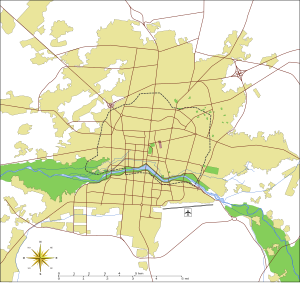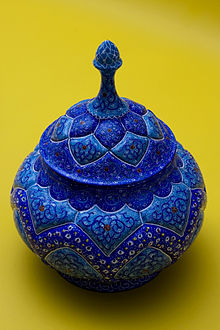| Isfahan (اصفهان) | |
|---|---|
| — city — | |
| Ancient names: Aspadāna, Spahān | |
| Montage of Isfahan, Top upper left:Khaju Bridge, Top lower left:Si-o-se Pol(33 Arches Bridge), Top right:Chehel Sotun Garden and palace, Bottom upper left:Naqsh-e-Jahan Square, Bottom lower left:Sheikh Lotf Allah Mosque in Ghal-e Tabarok area, Bottom right:Jameh Mosque in Shahahan area | |
| Nickname(s): Nesfe Jahan (Half of the country) | |
| Isfahan | |
| Coordinates: 32°38′N 51°39′ECoordinates: 32°38′N 51°39′E | |
| Country | |
| Province | Isfahan |
| County | Isfahan |
| District | Central |
| Government | |
| • Mayor | Morteza Saqaeian Nejad |
| Area | |
| • Total | 106,179 km2 (40,996 sq mi) |
| Elevation | 1,590 m (5,217 ft) |
| Population (2006) | |
| • Total | 1,583,609 |
| • Population Rank in Iran | 3rd |
| Population Data from 2006 Census[1] | |
| Time zone | IRST (UTC+3:30) |
| • Summer (DST) | March 21 – September 20 (?)(UTC+4:30) |
| Website | www.Isfahan.ir |
Isfahan (Middle Persian Spahān, Classical New Persian Ispahān) (Persian: اصفهان Esfahān), historically also rendered in English asIspahan, Sepahan or Hispahan, is the capital of Isfahan Province in Iran, located about 340 km south of Tehran. It has a population of 1,583,609 and is Iran's third largest city after Tehran and Mashhad. The Isfahan metropolitan area had a population of 3,430,353 in the 2006 Census, the second most populous metropolitan area in Iran after Tehran.[2]
The cities of Zarrinshahr, Fooladshahr and Najafabad, Se-deh, Shahin-shahr, Mobarakeh, Falavarjan and chiarmahin all constitute the metropolitan city of Isfahan.
Isfahan is located on the main north-south and east-west routes crossing Iran, and was once one of the largest cities in the world. It flourished from 1050 to 1722, particularly in the 16th century under the Safavid dynasty, when it became the capital of Persia for the second time in its history. Even today, the city retains much of its past glory. It is famous for its Islamic architecture, with many beautiful boulevards, covered bridges, palaces, mosques, and minarets. This led to the Persian proverb "'Esfahān nesf-e jahān ast" (Isfahan is half of the world).[3]
The Naghsh-e Jahan Square in Isfahan is one of the largest city squares in the world and an outstanding example of Iranian and Islamic architecture. It has been designated by UNESCO as a World Heritage Site. The city also has a wide variety of historic monuments and is known for the paintings and history.
Contents[hide] |
[edit]History
[edit]Prehistory
The history of Isfahan can be traced back to the Palaeolithic period. In recent discoveries,archaeologists have found artifacts dating back to the Palaeolithic, Mesolithic, Neolithic, Bronze andIron ages.
[edit]Elamite Empire
Ancient Isfahan was part of the Elamite Empire under the name of Aspandana also spelt Ispadana. It later became one of the principal towns of the Median dynasty. Subsequently the province became part of the Achaemenid Empire. After the liberation of Iran from Macedonian occupation by the Arsacids, it became part of Parthian Empire. Isfahan was the centre and capital city of a large province, which was administered by Arsacid governors. In the Sassanid era, Isfahan was governed by "Espoohrans" or the members of seven noble Iranian families who had important royal positions, and served as the residence of these noble families as well. Moreover, in this period Isfahan was a military centre with strong fortifications.
[edit]Persia's Capital
In 1598 Shah Abbas the Great moved his capital from Qazvin to the more central and Persian Isfahan. This ushered in a golden age for the city which lasted until it was sacked by Afghan invaders in 1722. The capital subsequently moved several times until settling inTehran in 1795.[citation needed]
[edit]Modern age
Today Isfahan, the third largest city in Iran, produces fine carpets, textiles, steel, and handicrafts. Isfahan also hasnuclear experimental reactors as well as facilities for producing nuclear fuel (UCF). Isfahan has one of the largest steel-producing facilities in the entire region, as well as facilities for producing special alloys.[citation needed]
The city has an international airport and is in the final stages of constructing its first Metro line.
Over 2000 companies are working in the area using Isfahan's economic, cultural, and social potentials. Isfahan contains a major oil refinery and a large airforce base. HESA, Iran's most advanced aircraft manufacturing plant (where the IR.AN-140 aircraft is made), is located nearby.[4]
Isfahan hosted the
نظرات شما عزیزان:










